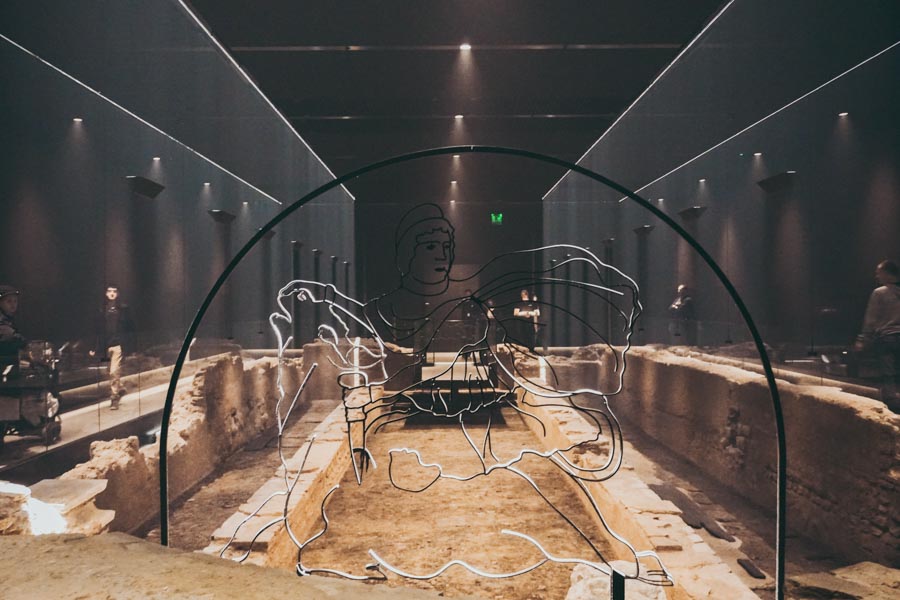
London’s history stretches way back – including to Londinium – the ancient Roman city that stood where the City of London does today. Ready to discover the remains of Roman London? Let’s explore.
Hidden amidst the streets of London, you’ll find the ancient ruins of the Roman Empire that formed the foundation of what the City of London is today.
Believe it or not, you can still take to the streets and see some of these ancient wonders with your own eyes.
From the ruins of the Temple of Mithras to the wall the Romans erected to protect it, the remains of Roman London sit between the city’s skyscrapers and contemporary buildings. They can be a little hard to find… that is unless you know where to look.
Where to Find Roman London
London Mithraeum
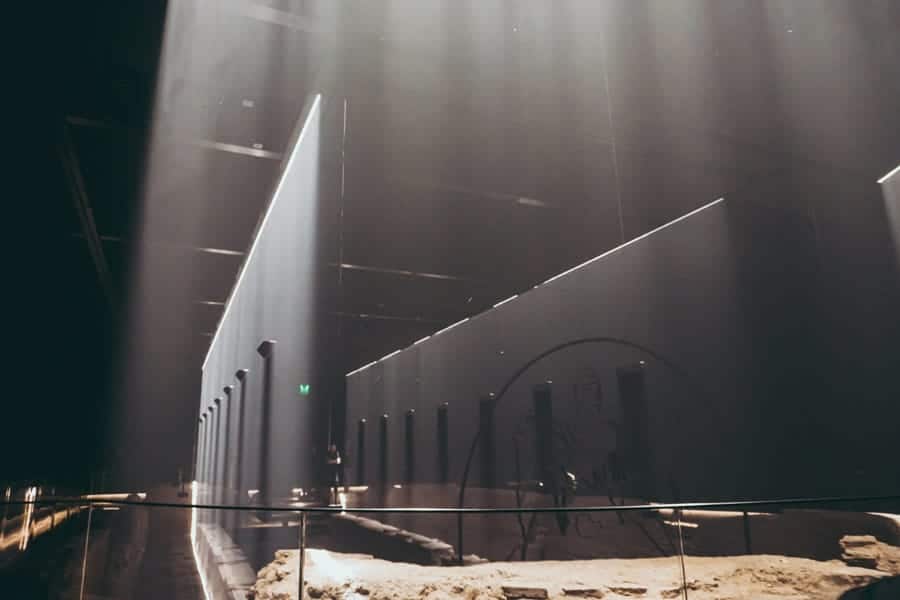
The Temple of Mithras was just one of the temples in Londinium, but historians think that it was also one of the most significant in the city.
Construction workers discovered the Temple in the 1950s, alongside an elaborate collection of different statues and trinkets of tribute while doing construction work in the area. The location of the ruins has changed twice because of this.
The first was pretty much as soon as it was discovered. Due to the importance of the building that was underway, the city delicately moved the structure to a new location in Queen Victoria Street, Temple Court.
It moved for a second time when the media giant Bloomberg built their European headquarters on the temple’s original location. Upon learning this, Bloomberg decided to transport the ruins back to their original location and rebuild the temple.
The ruins are open to the public and free to see. You can book a ticket through the Bloomberg Space and London Mithraeum website.
The headquarters also show some of the different artefacts discovered during the uncovering of the ruins of the temple.
London Wall
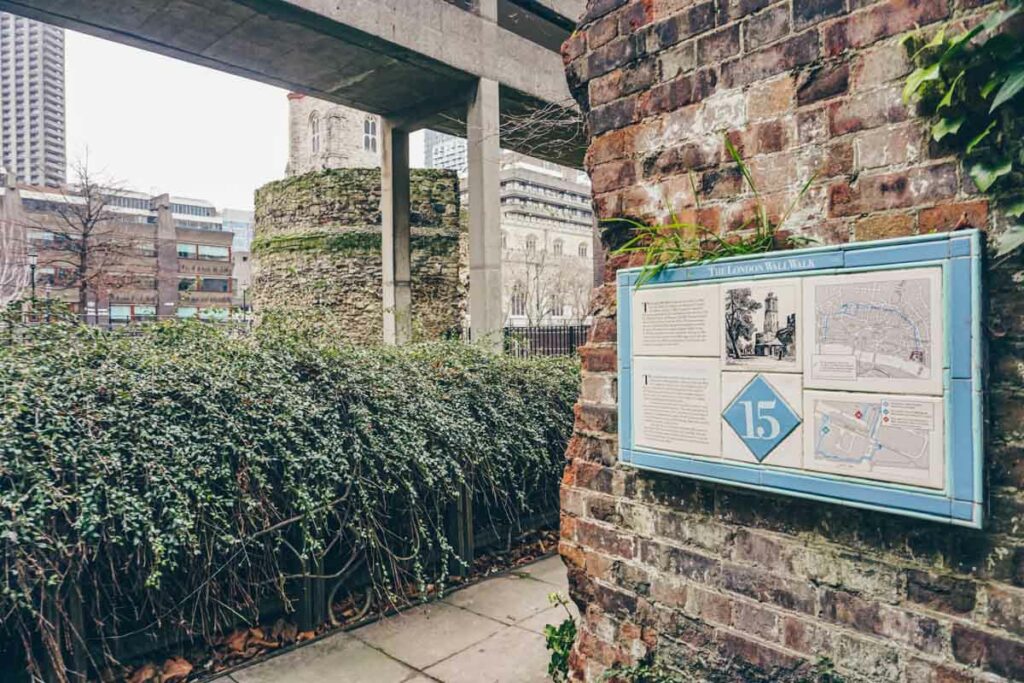
The Museum of London is one of our favourite free museums – a special place that houses thousands of different artefacts from cultures around the world, but there is a piece of Roman history surrounding it.
Take a walk around the outside of the museum, and you will find the remnants of a 5km-long piece of wall that the Romans built to encircle Londinium – imaginatively called London Wall.
This thick wall stands 6 metres tall and measures 2.5 metres wide. Its purpose was to protect the city over two thousand years ago.
Today, there are only a small amount of pieces that are still left. You will find other pieces near the underground station for Tower Hill and close to the Underground station for Barbican, on the Barbican Estate. But you will find the biggest piece of the Roman wall outside the museum.
Sadly, the rest of the wall has been destroyed, buried, or removed over the years with the rapid expansion and development of the City of London.
London Wall Road shows a different perspective of where the wall used to sit. This road mimics the north part of the wall and where it ran along the city’s edge.
Billingsgate Roman House and Baths
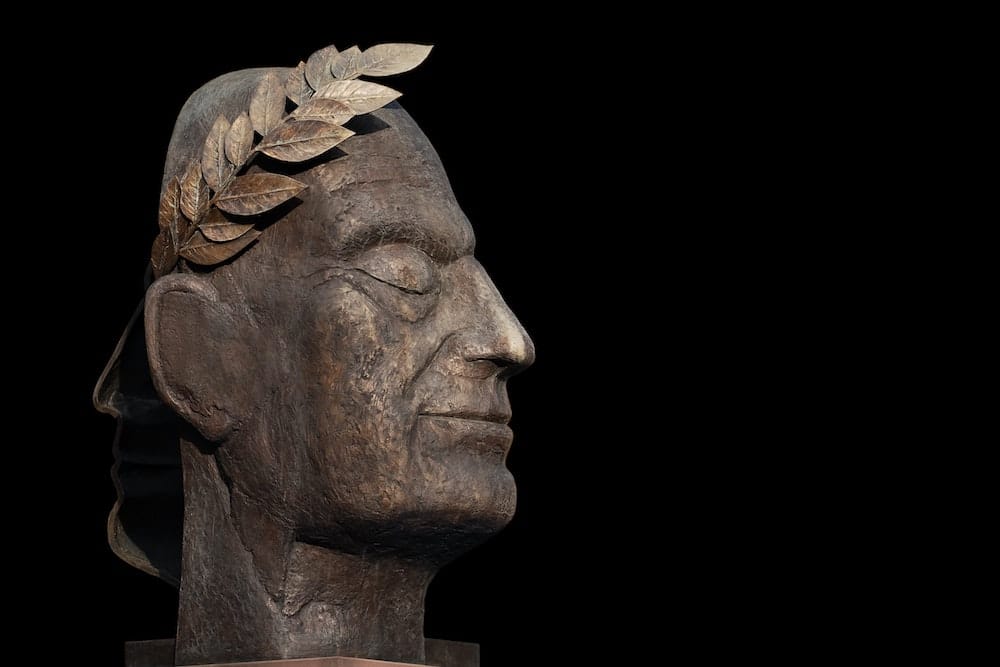
The Billingsgate Bath House is a 2,000-year-old ruin, discovered in 1848.
The artefacts inside show that it was built in the 2nd century on the bank of the River Thames, with a lovely waterfront view.
The Romans used it right up until they abandoned Londinium. This spectacular ruin even showcases modern features like underfloor heating.
You can walk to Lower Thames Street to experience this marvel of how the Roman British lived back then. It is one of the top examples of the style and type of Roman buildings within the capital.
The ruins were hidden from the public for a long time, in the cellar of a Coal Exchange building. Then the city destroyed this building to make way for another new development.
During this time, more excavations were undertaken and kept again in the cellar of the new building on Lower Thames Street.
Roman Fort
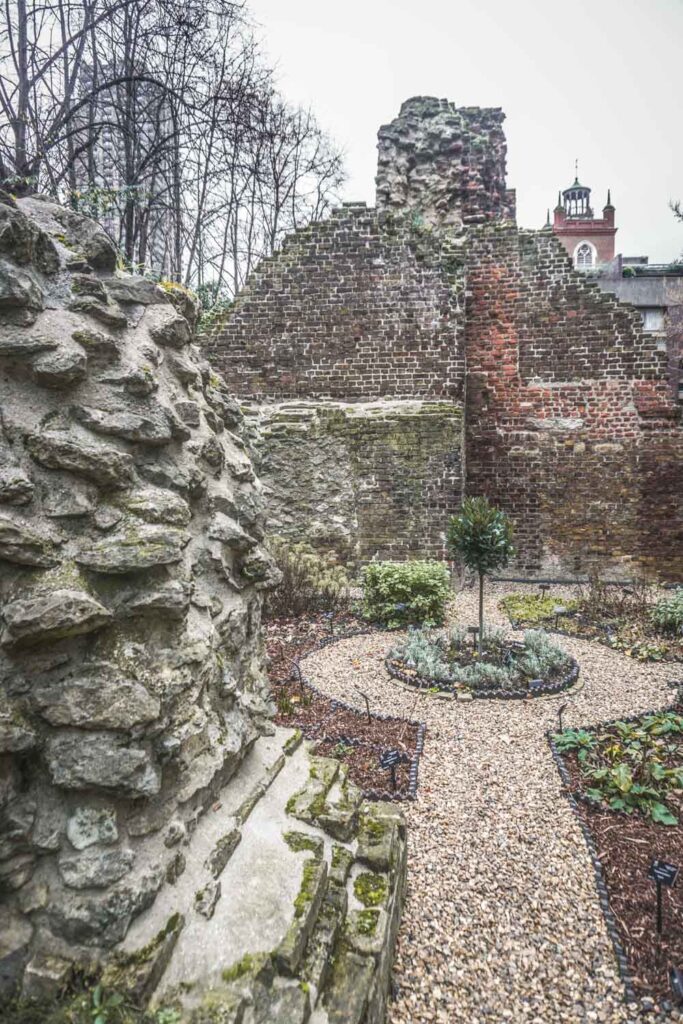
When the Romans were on their conquest of Britain, forts were the standard to protect their new settlements. The Fort of Londinium was built around 120 AD after local tribes burnt the original city to the ground.
The fort was built on the outskirts of the city and spanned an impressive 12 acres. Over the years, the city of Londinium grew. The fort was absorbed into the construction of the protective wall that encircled the city.
The military later decommissioned the fort as it was no longer needed — with stability coming to the region. A few pieces of the western and northern edges of the fort remain today within the Museum of London grounds.
Roman Amphitheatre of Londinium
Hidden in a vault under the Guildhall gallery are the remains of the Roman Londinium amphitheatre.
A group of archaeologists from the Museum of London discovered the remains while planning a new gallery project. The moment the archaeologists uncovered the ruins, they became a protected monument.
Originally made out of wood, during the 2nd century the structure underwent a renovation with a tiled entryway and stone walls added.
It could hold a few thousand visitors and the Romans used it for a variety of events, ranging from the infamous gladiator games to religious events and even executions.
These are the most impressive of all the Roman ruins in London, and they are free to visit during the gallery’s opening hours. If you stand in the courtyard above ground, there is an outline of the perimeter of the structure laid out in grey stone paving to show the sheer scale of it.
A Wharf Pilon from the Romans
Nestled in St Magnus, the Martyr church is a real Roman pilon dating back to the Roman period and still standing today. It is within the entry point of the church, below the bell tower. This pilon forms an integral part of what used to be the riverside wall along the river.
Builders discovered the pilon in 1931 when they were digging foundations for a building nearby.
A scientific study was done on the wood, and it was dated to roughly 75AD. It is incredible how a piece of wood has survived thousands of years.
A Recent Discovery
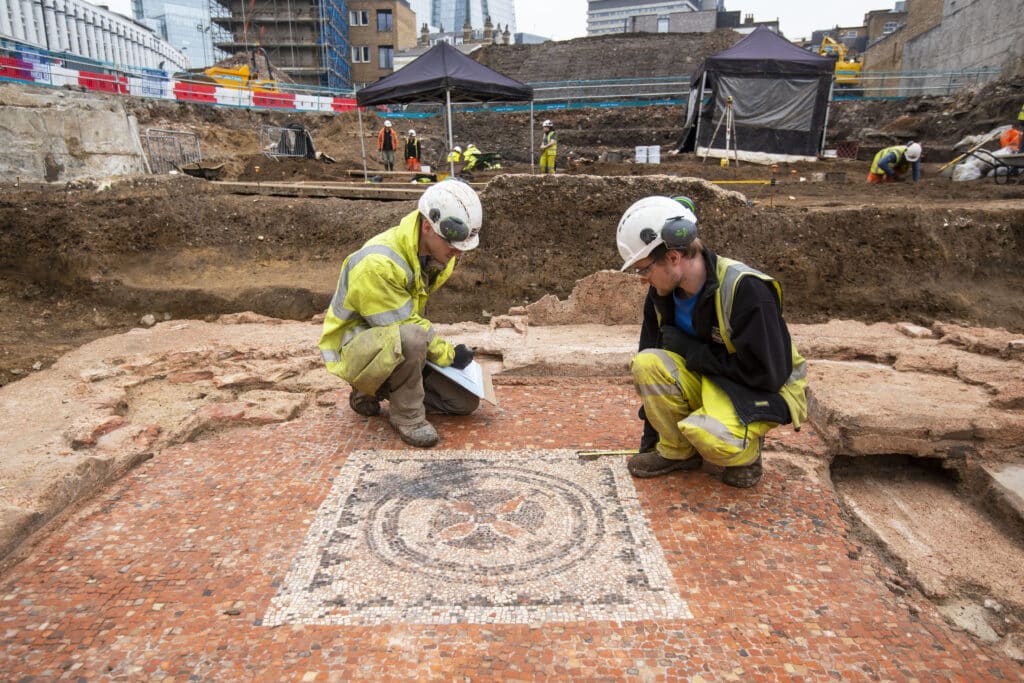
The summer of 2023 turned up a pretty interesting find for Roman-London enthusiasts. While digging around the site of The Liberty of Southwark site – where some fantastic mosaics were found previously – a fantastic example of a Roman mausoleum was discovered.
It’s said to be the best-preserved Roman mausoleum in the UK, but don’t expect to see much of a structure. The best part of it has long been pulled down, likely by Londoners in the middle ages.
What remains has been slated for public viewing once the Liberty of Southwark site is completed.
Roman London Walk
The best way to experience all of these things — and more — is to take a Roman London walking tour. This will take you to the sites above and provide you with a guide who can also inform you about all the unique aspects of the ruins.
Much of the remains are 7 metres below ground so you have to know where to look. Here is an outline of a path to follow.
London Wall at Tower Hill

The walk will take around three hours from start to finish with Tower Hill being the best place to start, where you will see your first piece of the London Wall. Take the underground to Tower Hill station and just outside will be a large chunk of the wall.
Billingsgate Baths on Lower Thames Street
Take a stroll down Lower Thames Street towards the London Bridge and stop at the Roman Baths next to St Dunstan’s Hill. Not too far away from where you started.
London Mithraeum on Walbrook

Further down the road, opposite the Cannon Street Station and in the Bloomberg Building, is the London Mithraeum, where you can marvel at the ruins of the Roman Temple. Granted, this is a bit more of a walk to get to here but your feet won’t get too tired.
Londinium Amphitheatre At Guildhall Gallery
A short walk up King Street will take you straight to the incredible Amphitheatre ruins of Roman Londinium.
Museum of London on London Wall Street
Just up the road will be the end of your walk at the London Museum. Here you will find the remains of a large piece of the London Wall and the ruins of the Roman Fort that once stood there. End of your walking tour with a simple and relaxing walk along the London Wall Road to trace the original wall location and take you back to Tower Hill.
Feel like exploring all the ruins? Well, the good news is that there is a walking tour to show you the remains of Roman Londinium and provide expert knowledge while doing it. There are also a few extra hidden Roman ruins that you might not have heard of before on this walking tour of Roman Londinium.
A Brief History of Londinium
The history of Roman London is quite long – so we’re giving you the short version here.
During the Roman period, Londinium was known as Roman Britain’s capital. The original area — first built in 47AD — was only a settlement, sitting on what is today the City of London.
Londinium’s Importance
It was a strategic settlement, located at an important point to cross over the Thames. This made it an important port serving as a commercial epicentre for the Roman Empire on the British island.
There has been a bridge at this important crossing point ever since in one form or another. The Romans built the Roman London Bridge to take Londinium citizens over the River Thames.
Archaeologists discovered the foundations of a substantial pier foundation in the early 1980’s close to the London Bridge.
The Rebuilding of Roman London
A coalition of local tribes destroyed the original settlement during an uprising, but the Romans rebuilt the city after. Romans built the new city according to the standard Roman philosophy of a grid layout, and by 225 AD, they encased it within a wall.
The Roman London wall still exists today, and pieces of it still hold the City of London within it.
The Fall of Londinium
The city hit its peak in the 2nd century, but the status of Londinium started to fall in the 5th century. During this time, the Roman Empire began to weaken after the Barbarians invaded Roman territories and other major cities of the Roman Empire cut communications.
Londinium was effectively abandoned and fell into a state of disrepair.
It only became relevant once again during King Alfred’s reign, where the city was used to protect the countrymen from the invading Vikings. At this time, the name was also changed to Lundenburg.


